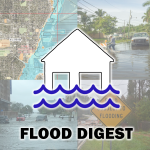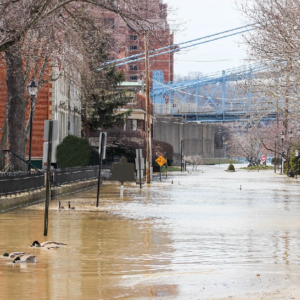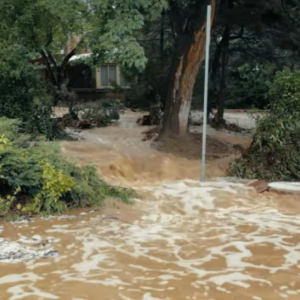More than two-thirds of residential claims not covered
 Less than a third of Florida’s Hurricane Debby residential property claims were paid before being closed, as those caught without flood insurance become more evident; a new look at flooding risk across the nation and the growing coverage gap; plus a 30 year-old effort by FEMA to literally move people from flooded properties. It’s all in this week’s Flood Digest.
Less than a third of Florida’s Hurricane Debby residential property claims were paid before being closed, as those caught without flood insurance become more evident; a new look at flooding risk across the nation and the growing coverage gap; plus a 30 year-old effort by FEMA to literally move people from flooded properties. It’s all in this week’s Flood Digest.

Flooding in the Laurel Meadows neighborhood of Sarasota from Hurricane Debby, August 5, 2024. Courtesy, WTVT-TV Fox 13 Tampa
Hurricane Debby Aftermath: As we enter the heart of hurricane season, it’s clear the biggest threat may be future rainfall here in Florida. That was certainly the case with Hurricane Debby which made its Florida landfall on August 5 but did most of its damage on the way to landfall. Insured losses now total just under $125 million; about a third are automobile and “other” and the remaining two-thirds residential property. Nearly 70% of the residential property claims are closed with only 31% closed with payment. Ostensibly, most of the other 69% were denied because ground flooding is not covered by standard homeowners policies. Take Sarasota’s Laurel Meadows development for example which is classified as a Zone-X (low to moderate flood risk) by FEMA. The neighborhood was inundated by Debby’s heavy flooding rains and, as reported by Nadeen Yanes of WFTS-TV ABC Action News, only 4 of the 86 homes had flood insurance. In my interview for the story, I reviewed the options those without such insurance have – none will make them whole. “They can take out a personal loan or if they’ve got equity in their home, borrow with that. Secondly, see what FEMA has to offer. It might not be much, but it could help. And third, a lot of people just sell their homes and walk away,” I advised. You can watch the entire 7 minute interview midway down the story here.
Federal funding for Debby victims to date includes $25.4 million in FEMA grants to 7,160 households (that’s an average payment of $3,547), $14.6 million in U.S. Small Business Administration disaster loans, and $26.4 million in National Flood Insurance Program claim payments. The deadline to apply for FEMA assistance is October 9, 2024.
 The Bigger Flood Picture: The flooding aftermath from Hurricane Debby is reflected across the nation as chronicled in the recent Wall Street Journal article Flooding Is Getting Worse—and Fewer Homeowners Have Insurance. Reporter Jean Eaglesham nailed it in revealing the large and growing gap between flood risk & flood insurance coverage in the U.S. As I’m quoted “If your driver’s license says Florida, you live in a flood zone and you’d better buy flood insurance.” Many in her story historically haven’t needed the coverage. FEMA flood maps show the likelihood of floods across the nation, but don’t take into account the rainfall risk we’ve seen in recent years – and many are out of date, with around 20% being at least 10 years old. There is also a disparity between FEMA’s estimated risk of flooding and the actual number of homes facing such a disaster. One private modeling firm’s simulation estimated that 78% of flooded properties from Hurricane Debby were outside of FEMAs high-risk zones.
The Bigger Flood Picture: The flooding aftermath from Hurricane Debby is reflected across the nation as chronicled in the recent Wall Street Journal article Flooding Is Getting Worse—and Fewer Homeowners Have Insurance. Reporter Jean Eaglesham nailed it in revealing the large and growing gap between flood risk & flood insurance coverage in the U.S. As I’m quoted “If your driver’s license says Florida, you live in a flood zone and you’d better buy flood insurance.” Many in her story historically haven’t needed the coverage. FEMA flood maps show the likelihood of floods across the nation, but don’t take into account the rainfall risk we’ve seen in recent years – and many are out of date, with around 20% being at least 10 years old. There is also a disparity between FEMA’s estimated risk of flooding and the actual number of homes facing such a disaster. One private modeling firm’s simulation estimated that 78% of flooded properties from Hurricane Debby were outside of FEMAs high-risk zones.
 FEMA’s Flood Relocation Program: FEMA is out with a nice summary of its home buy-out program, which has provided approximately $3.4 billion for nearly 62,000 property acquisitions across the U.S. over the last three decades it has been in effect. FEMA plays a crucial role in disaster management and risk reduction, particularly in mitigating high flood-risk properties. One of their tools is the FEMA-Funded Residential Property Voluntary Flood Buyouts, which help communities increase resilience by acquiring flood-prone properties and converting them to open spaces. Homeowners receive fair market value for their properties, which the program facilitates through various assistance programs. The blog above contains some interesting case studies from different communities.
FEMA’s Flood Relocation Program: FEMA is out with a nice summary of its home buy-out program, which has provided approximately $3.4 billion for nearly 62,000 property acquisitions across the U.S. over the last three decades it has been in effect. FEMA plays a crucial role in disaster management and risk reduction, particularly in mitigating high flood-risk properties. One of their tools is the FEMA-Funded Residential Property Voluntary Flood Buyouts, which help communities increase resilience by acquiring flood-prone properties and converting them to open spaces. Homeowners receive fair market value for their properties, which the program facilitates through various assistance programs. The blog above contains some interesting case studies from different communities.
LMA Newsletter of 9-16-24

